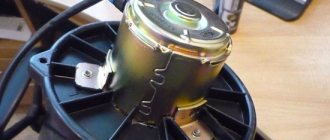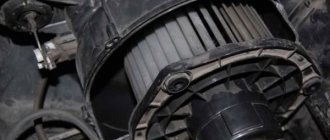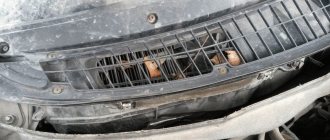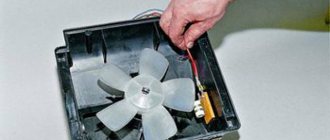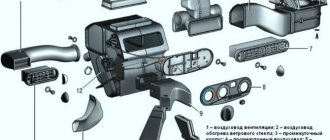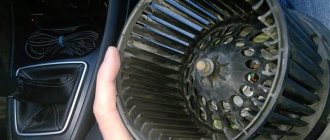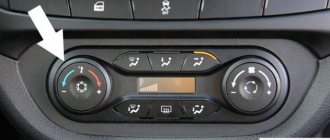The “classic” of the domestic automobile industry represented by the VAZ-2106 model is considered quite reliable in terms of the design of the main units, including the heating one. But age and gradual wear of parts sooner or later makes itself felt. A signal that repairs or a complete replacement of the VAZ-2106 heater fan is required is a banal lack of heat when the heater is turned on.
Stove fan
Structurally, the fan consists of a DC electric motor with a commutator-brush assembly and an impeller mounted on the electric rotor. motor. The electric motor is powered from the vehicle’s on-board network. There are several modes of fan operation, the difference between which comes down only to the rotor rotation speed, and this is realized by inserting a resistor into the power supply circuit of the electric motor.
The fan operating mode is set using a handle located in the heater control unit on the center console. Initially, on the VAZ-2110, this handle was part of the design of the SAUO controller, but functioned separately from the controller itself. Later, the ACS added an automatic fan control function (position “A” on the handle), using which the controller regulates the rotation speed of the electric motor in order to maintain the set temperature.
The electric motor used in the design of the VAZ-2110 fan is simple, but it has “weak points” - the commutator-brush assembly and bearings. Wear of these elements causes incorrect operation and complete inoperability of the fan. Short circuits and winding breaks in the stove drive are rare, but don’t forget about these breakdowns either.
Symptoms of failure. Heater components that affect fan operation
Signs of a malfunctioning stove fan are quite obvious and impossible not to notice. Common symptoms of failure:
- Increased noise, grinding noise during operation.
- Significant reduction in air injection efficiency.
- The fan does not turn on.
- Spontaneous change in the rotation speed of the electric motor.
- It can be determined by ear that the electric motor is operating under heavy load.
In some cases, such consequences result from malfunctions in the power supply and fan control circuits, so you should check them first. This applies to:
- fuse (blowout is the cause of complete failure of the electric motor);
- resistor (if it is faulty, some speed modes of the electric motor stop working);
- controller (the knob for switching fan modes is part of its design, so malfunctions of the automatic control system affect the functioning of the electric motor);
- wiring terminals of the power and control circuits (oxidation, damage to wires is one of the reasons for a malfunctioning electric fan).
If diagnostics of these elements shows that they are in good working order, it is necessary to dismantle and repair the fan itself. But it can be diagnosed first.
Fan check
A check is done by directly powering the electric motor from the battery (we lay wires from the battery terminals and connect them to the power terminals of the motor) - operation under load, difficulty in gaining rotation speed, squeals and squeaks indicate wear of the drive components and the need to replace them. But if, even with direct voltage supply, the electric motor does not start, it is most likely that it has burned out or the windings have broken. Such faults are difficult to fix and it is easier to replace the entire unit.
Design features of the stove of the old and new models
The design of the electric motor of the stove on the VAZ-2110 is identical, but the fans and their location are different. On models of the first years of production, the electric fan is installed in the stove housing in front of the radiator and it is located horizontally (old-style stoves). Afterwards, the design was revised - the fan was already placed in the cabin filter housing and installed vertically (new model heaters).
Despite the design features, dismantling the fan is a simple operation and does not require complete disassembly of the stove.
On a VAZ-2110 with an old-style heater, to remove the electric fan you need to:
- Dismantle the frill.
- Remove the front wall of the niche in which the heater is located.
- Remove the back cover of the fan housing by first unscrewing the screws and removing the clamps.
- Disconnect the wiring from the fan and remove it.
As for models with a new type of stove, the technology for removing the electric stove fan on such cars is different:
- dismantle the “jabot” and the front wall;
- remove the air filter;
- unscrew the fastening of the filter housing to the stove body and separate them;
- disconnect the wiring;
- remove the filter housing together with the fan;
- dismantle the electric fan.
After removing the electric motor with the impeller, we disassemble it, perform troubleshooting, replace worn elements and put it back together.
The stove doesn't blow at all, what's the problem?
If the heater fails, you can do the initial fault diagnosis yourself.
Unfortunately, the complex heater control system has not proven itself as a device that allows you to take the hassle off the driver and automatically maintain the set temperature. Instead, we got a lot of trouble and cold interiors in the frost. Let's go from simple to complex and first let's look at the problems with the electric heater motor. Everything is more or less simple here:
- Fuse. We turn on the stove, it doesn’t work. If we were lucky, the fuse had blown. Finding it is as easy as shelling pears, it is more difficult to find out the reason for its burnout. The 25-amp fuse F18 is located in the main mounting block; it also protects the circuit for the glove compartment lighting, heated rear window and is partially related to the cigarette lighter, so it is easy to diagnose its failure. And in order to find the short circuit that caused it to burn out, you will have to call all these circuits - the glove compartment light, the rear window heating, the headlight washer and the cigarette lighter.
Heater fuse location.
We check the contacts on the heater control unit and the electric motor.
Video about replacing the VAZ-2110 heater motor
Checking the automatic heater control system
The stove control system can also give out surprises. They consist in the fact that one of the speeds may not work, several, or only one, the most powerful, may work. At the same time, the SAUO block is not universal and is selected depending on the year of manufacture of the car:
One of the reasons for the failure of the stove may be the unit of the automatic heater control system.
- 2110-8128020-03 , price 2300 rubles, applies to the last ten years of production;
- 21102-8121020 , price 3100 rubles, installed on cars with air conditioning;
- 2110-8128020-02 , about 2 thousand, were put on the first ten years of production;
- 2110-8128020-01 , 1840 rubles, used on some cars until 2000.
Nevertheless, the design of all units is similar, only some parameters are different, and the signs of malfunction are similar for all.
Replacing the heater radiator on VAZ 2110 and 2112. When the resource is exhausted
- Old model (until 2003);
- New model (since 2003).
- Remove the rubber seal from the wind lining;
- The fasteners are unscrewed and the frill is removed;
- Remove the windshield trim. To do this, unscrew the nuts and screws located along its edges;
- The hose is removed from the front window washer. It should be moved to the side, otherwise it will interfere with further work;
- Unscrew the wiper fastenings;
- The cover (wind deflector) is finally removed;
- The metal clips are removed from the stove body. They are examined carefully, if corrosion is visible on them, then they need to be replaced with new ones;
- Remove the filter in the cabin, which is attached to the heating radiator with screws; Turn off the fan. To do this, remove the positive connector and unscrew the nut from the negative terminal (on the body);
- Unscrew the 3 screws securing the stove cover;
- Loosen the hose clamps. We remove the radiator.
- The supply hoses are dismantled. Also remove the steam exhaust hose. It is enough to disconnect it from the stove. They are all attached to clamps;
- Chips are removed from the fan;
- The gear motor is disconnected from the power supply;
- Unscrew 3 screws securing the gear motor;
- We find the places where the radiator is attached to the body and unscrew the screws;
- Unscrew the screws from the filter cover. We extract it;
- Unscrew the screws securing the radiator halves;
- Now you can remove the heater itself. We first pull out the left part, then the right;
- Unclamping the brackets, remove the damper.
Causes of malfunction
Replacing the heater motor of a VAZ 2110
As a rule, there are many reasons for such a malfunction, these include:
- clogging with slag from the stove radiator;
- stove motor failure.
If the stove motor is not functioning, or some of its speeds are not working properly, then it is first recommended to check the resistor, which in other words can be called the stove rheostat. This element is responsible for the speed of the fan. You can purchase such a part in a specialized store that sells auto parts. As for replacement, this can be done with the help of a specialist or on your own, which is not so difficult even for an inexperienced specialist.
Note! In the case of repairing or replacing the heater radiator, it is recommended to contact a car service center, since it is difficult to remove the radiator yourself. To replace the stove motor, you will need minimal knowledge and detailed instructions.
There are heater malfunctions that can be easily fixed by any car enthusiast. For example, a situation may occur when cold air is blowing through the side deflectors and the windshield heating duct of the heating system, while a hot air flow comes from the lower and central air ducts. Most likely, the reason will be the unsatisfactory operation of the heater damper, which is designed to cut off cold air. In some cases, it prevents the normal passage of cold air. Such faults are most easily identified in the cold season
When bending the damper drive rod, special care must be taken so as not to damage the plastic parts. Please note that in winter the plastic becomes more fragile
Replacing the motor for the stove on a VAZ 2110
Of course, a non-functioning stove causes many problems in winter.
If this is not so important in the summer, then in the winter the windows will fog up. You can figure out what the reason is when disassembling the heating system of the car
Carrying out repair work at SAUO
Note. Before you begin repair work on the self-propelled control system, you must make sure that the problem with the furnace malfunction lies in the controller.
VAZ 2110 stove controller
In order to make sure that the furnace controller is really in good condition, you need to replace its non-working version with a working one, having first taken a working controller from a store or from a friend, comrade, etc. If the problem is not in the controller, then you need to contact a service center for professional diagnostics and troubleshooting.
Note. You should never rule out other options for furnace malfunction.
The above information and instructions will be useful only if they are reinforced with the help of photos and video materials, since they, in combination with theoretical information, will help to correctly present the picture of what is happening. The advantage of diagnosing a controller replacement with your own hands is, first of all, the price, and the advantage of a car service is professionalism.
Preparing for replacement
If you have at least some skills in working with wrenches and screwdrivers, replacing the stove motor will be a feasible repair for you.
To get to the electric motor of the VAZ 2110 heater, you first need to open the hood and remove the “-” battery terminal.
Now, in fact, we are removing the motor itself, which does not work as we need, or has completely failed:
- The windshield wipers need to be removed. To do this, pry off and remove the rubber caps, take a 10mm wrench, unscrew the nuts, disconnect the brushes;
- We pry up the decorative plugs (a slotted screwdriver is useful here), unscrew the screws that secure the frill, then a couple more nuts on the edges (with a 10mm socket wrench), remove the frill;
- Having removed the rubber seal, unscrew the screws with which the engine compartment shield is attached;
- Now, remove the hose that supplies washer fluid to the injectors;
- The most difficult task is getting to the right side of the engine compartment to remove it. It has two nuts at the bottom (also for a 10mm socket wrench). It would seem easy to unscrew, but it’s just painfully inconvenient. Although there is a positive point here - these nuts do not have to be completely unscrewed - the shield can be pulled out after a few turns;
- Before disconnecting this shield, remove the clamps from the hose going to the vacuum brake booster;
- Unscrew the screws (4 pieces) from the cabin filter cover and remove it;
- The heater motor has already appeared. It is necessary to disconnect the heater motor block, as well as the resistor block;
- Now you can pull out the left side of the stove, and with it the fan motor;
- It became possible to replace the heater fan;
- Reassembly is carried out in the same order, only exactly the opposite.
Be prepared for the fact that for the first time replacing the heater motor on a VAZ 2110 (repair) will take you a couple of hours.
How to prepare for the event
If you need to repair a VAZ stove fan, you need to make sure you have the necessary tools:
- head 10 millimeters, deep;
- Phillips screwdriver (2 varieties: regular and short);
- ratchet with extension.
Only if all the tools are available can the main activities be carried out. Of course, for a successful result, at least minimal experience with wrenches and screwdrivers is required. If there is no relevant experience, the task at hand becomes significantly more difficult.
Possible causes of malfunction
Before carrying out repairs, you should carefully study the possible causes of a malfunction of the car heater fan:
- Burnt fuse. The real reason is the most banal and simple, but at the same time it is the one that leads to the greatest problems in solving the existing issue. Replacing a fuse turns out to be a very simple procedure that any motorist can successfully handle. Despite simple repairs, it is extremely difficult to detect the short circuit that led to the blown fuse.
- Oxidation of contacts that should be used to establish the operation of a car heater.
- The ignition relay does not allow the heater to turn on and start working successfully.
- An additional resistor can result in only the third speed being operational.
- A faulty car interior heating switch requires replacing the fuse.
- A non-working electric fan motor is another important reason. In this case, it is necessary to replace the heater motor or at least check its contact with the vehicle. In most cases, the cause is hidden in a burnt-out electric motor, poor contact with the machine, or sticking electric motor brushes.
Regardless of the cause of the malfunction, you can successfully adjust your car heater
The most important thing is to understand what exactly is the cause of the breakdown or partial disruption of the functionality of the heating equipment
If diagnostics have confirmed that the cause lies in the heater motor, replacing the heater fan most often becomes a mandatory task. How to carry out such a responsible procedure and how easy does it promise to be?
The radiator fan on the VAZ-2114 is used to forcibly cool the engine and cooling system when natural cooling is insufficient. It turns off especially often if the temperature sensor is broken.
Its failure can lead to unexpected consequences, therefore, it is necessary to determine the cause of the malfunction in a timely manner and eliminate it. If the motorist is unable to do this, then it is worth contacting a car service center.
Throw off the » — » battery cable to replace the fan of the VAZ 2110 stove
2. Disconnect the “+” connector of the heater fan wires
3. Using a ten key, unscrew the nut...
4...and remove the negative wire.
5. Use a screwdriver to unfasten the four brackets...
6. carefully bending the lid,
7. Remove the stove fan and replace it with a new one if it is not possible to repair it.
When installing the electric motor, make sure that it does not touch the housing when rotating.
How to check the heater damper micro-reducer
To test the micro gearbox, you must use an ohmmeter. On older versions of SAUO controllers, the minimum resistance should be in the range from 800 to 1,200 Ohms. In new samples this figure is 3.5–5 kOhm. Set the minimum mark on the heater control unit and wait 15 seconds. Next, simply disconnect the controller connector, measure the resistance between contacts X1.4 and X1.1.
When the temperature is set to the maximum level, the multimeter should output 3.2–5 kOhm, taking into account the fact that an old version of the controller is used. On the new one the indicator is 1.2–1.6 kOhm. If the indicators do not change, it means that the micro-gearbox shaft position sensor on the VAZ is faulty. In this case, take the car to a service center, as the replacement process requires the intervention of a professional. If you want to carry out the replacement yourself, carefully follow safety precautions.
There is no need to rush, as careless handling of spare parts can damage other components, which in turn will lead to even greater expenses and a mandatory visit to a service station. It is also recommended to purchase only high-quality equipment, because used spare parts can quickly become unusable and fail you at the most inopportune moment.
How to replace the heater fan on a VAZ 2110-VAZ 2112
These instructions for replacing the heater motor are suitable for many cars of the tenth family, but not for all, because dozens were produced in very different configurations and designs over the entire time, some VAZ 2110 even had an engine from Opel installed from the factory, such a car is marked VAZ 21106, therefore, we won’t be able to write about everything (since it will be a very long article), we’ll just take the most common tenth family and use its example to show how to replace a stove motor through descriptions and pictures!
1
First of all, you will need to get to the motor, it is hidden under a trim that is located under the windshield, and inside this trim, the motor is still placed in a casing, so you will have to remove a lot of decorative elements, in more detail how to do this is described in the article entitled: “Replacing the cabin filter on a VAZ 2110” and by the way, the trim that is located under the windshield cannot be removed without removing the brush, and when you lift it, pay attention there will be a tee under it (see the large photo for the location where it is located) , disconnect the hose from it that is connected at the bottom (see small photo) and the trim can then be removed from the car
2. We go further, as soon as all the elements that prevent access to the casing in which the motor is located are removed, find the wires coming from the motor, or to be more precise, one Plus wire and one Minus wire, so the minus (Indicated by a green arrow) is attached to nut (Indicated by a blue arrow), you unscrew it, but the plus (Indicated by a yellow arrow) is connected to the other wire through a wire block and a connector (see small photo), disconnect them from each other.
3. Then, using a flat screwdriver, pry out the four latches (They are indicated by arrows) that fasten two casings together, on one of which the stove motor is attached. Be sure to replace any latches that will be broken during their removal with new ones during reassembly. It is recommended to install all the fasteners in their places to prevent the housings from moving between each other.
4. And finally, unscrew all the screws that hold the casings together, there are only about 8 or 10 of these screws (We could be wrong), when they are all unscrewed, the casings can be separated (see small photo), but just remember where the screws go they are twisted because they have different lengths and you cannot wrap the long ones where the short ones should be located and vice versa.
The stove motor can be removed assembled with the casing, or you can immediately take it out separately, it’s up to you how to do it, but having taken out everything assembled, it will be much easier to disconnect the motor (since it will be more convenient), and the motor is separated in the following way, you will only need just remove two wires (minus wire and plus wire) from the hole into which they are threaded in the casing and that’s it!
5. Installation is carried out in the reverse order of removal, after installing the stove, you will have to use the help of an assistant and find out whether you installed the stove correctly in its normal place or with a skew (If it is skewed, then this will need to be removed immediately), in general, closer to topic, ask an assistant or even get into the car yourself and turn on the stove, while assembling it, i.e. tighten the fastening screws (You don’t even have to tighten everything) and install the clamps and, of course, put the minus on the body, and connect the plus to the connector, then turn it on and if everything works fine in all modes, then turn it off and go tighten the last screws, install the covers under windshield and of course install the brushes, the replacement is complete, if after turning on you hear a crackling noise, then this only means one thing, namely that the heater blades are touching the body in which it is located, then turn off the heater and unscrew the screws , remove the clamps and remove the body together with the stove, place the motor there correctly, tighten everything again and try until the noise disappears, just like it disappeared, screw everything back and install all the parts in the reverse order.
Work to replace the fan in the cabin
Replacing the heater motor of a VAZ 2110
The subsequent change of the heater motor will be done directly from inside the car:
Under the dashboard you need to find the block that goes to the electric motor. She disconnects. After this, you will need to unfasten the ground wiring of the electric motor. As a rule, it is pressed to the body by the front mounting nut of the heater. The trim and lining of the windshield frame are dismantled, and you cannot do without unscrewing the mounting screws. The right upholstery is removed from the interior heater, and the fastening nuts and screws should also be unscrewed. Heating hoses are disconnected
At this stage of work, extreme caution must be taken, since antifreeze residues may leak from these hoses and the heater radiator. To prevent the smell of coolant in the car interior, you need to lay a material that absorbs moisture well. The wiring is disconnected from the electric motor, from the micro-reducer, and also from the pneumatic valve. After these steps, remove the front housing with the stove casing. These elements are fixed with brackets and screws. It is worth noting that the engine and motor are located on the casing. The latches are removed, and the engine and motor are removed.
Recommendations for replacing the motor
Replacing the heater motor of a VAZ 2110
You can disassemble the electric motor yourself only to evaluate the collector and clean it. If the cause of the breakdown lies in another situation, then it is not advisable for a non-specialist in working with such parts to disassemble it. It is better to buy a new electric motor.
Note! It is also not recommended to dismantle the engine impeller on your own, since when it is installed in its place, the balancing, which plays an important role, will be disrupted. Naturally, the electric motor will function, but not smoothly, which can lead to breakage of the bearings and noise when the stove is turned on.
Since the stove is in a disassembled state, it becomes possible to calmly view the other components of the cabin heater. So:
- In order for more heat to come from the radiator, you need to dismantle it and wash it. It is fixed on the rear casing of the heater, which is removed by unscrewing the mounting screws. After this, the radiator can be easily removed and washed under the pressure of water flowing from a hose that is connected to the radiator inlet or outlet tube. The same pressure washes away dirt from the surfaces of the removed radiator.
- To disassemble the air ducts and heater control mechanisms, you will need to remove the instrument panel on which the main air ducts are located.
Note! Usually the panel with the main air ducts is made as one piece, so it must be handled with the utmost care so that it does not have to be replaced later. After this, you need to remove the interior air ducts, which are secured with special screws, and the decorative lining of the floor tunnel
After this, you need to remove the interior air ducts, which are secured with special screws, and the decorative lining of the floor tunnel.
Note! Under this trim there are air ducts for heating the feet, which are attached to the body with screws and latches.
- The air distributor is removed from the dashboard by unscrewing the mounting screws and disconnecting the damper control rod.
- Reassembly must be done in the reverse order of disassembly. If necessary, fix the damper seals with glue. You can also seal the attachment points of the hoses with the radiator with sealant.
- When all the parts are assembled and installed in their places, the functioning of all components is checked and antifreeze or antifreeze is added. It all depends on personal preference.
- At the final stage, they check the tightness of the attachment of the hoses to the radiator and the actual operation of the assembled stove.
For those who perceive information visually, it is recommended to watch a video with a detailed description of the actions and several photos that will help you do everything correctly.
Repair work can be carried out with your own hands, but subject to clear instructions. This will help you save a lot of money, because the price for services of this kind in car services is not cheap.
Causes of malfunction
There can be many nuances that the heater motor has begun to work poorly. Among them are two main ones that can be helped by a small repair rather than a complete replacement of the fan. The commutator brushes may well wear out. The brushes themselves, in turn, can “gnaw through” the copper lamellas of the collector, which is why it does not want to work, and the heater motor “goes silent.”
Although this happens quite rarely, brass sleeves of plain bearings can squeak or whistle. Repairs are made by regular lubrication, although this usually helps for a short time; sooner or later the electric motor will need to be replaced. So, if you still have to get to the furnace fan, perhaps replacing it completely will be the best solution. In addition, it saves your time.
Signs of a malfunctioning heater motor
First of all, you need to check the fuse.
It often turns out that this is the problem. If the heater fuse is blown for any reason, it should be replaced. If after replacing the fuse the stove still does not work, then you should proceed to dismantling and replacing the motor itself. The first sign of a malfunction of the heater motor on a VAZ 2110 may be noise from the motor itself. The reason for this sound may be the lack of lubrication on the engine, or it may indicate the imminent death of the heater motor on the VAZ 2110
Adjusting the automatic control system
To check the functionality of the device, you should take a mercury thermometer and place it near the temperature sensor. After this, you need to activate the stove controller and set the fan control knob to position “A”. The automatic control system should be carefully adjusted only if after 15–20 minutes the temperature is more than two degrees below the data from the sensor.
In order for the self-propelled gun to work better, you will have to pull it out and then turn the knob located on the left side of the controller several times. You can increase the temperature by turning the knob clockwise, and decrease it by turning it counterclockwise.
After all the manipulations performed, you will need to check the functionality again and, if necessary, repeat everything from the beginning.
Causes of malfunction
As a rule, there are many reasons for such a malfunction, these include:
- clogging with slags from;
- stove motor failure.
If the stove motor is not functioning, or some of its speeds are not working properly, then it is first recommended to check the resistor, which in other words can be called the stove rheostat. This element is responsible for the speed of the fan. You can purchase such a part in a specialized store that sells auto parts. As for replacement, this can be done with the help of a specialist or on your own, which is not so difficult even for an inexperienced specialist.
There are heater malfunctions that can be easily fixed by any car enthusiast. For example, a situation may occur when cold air blows through the side deflectors and the windshield heating duct of the heating system, while a hot air flow comes from the lower and central air ducts. Most likely, the reason will be unsatisfactory performance, which is designed to cut off cold air. In some cases, it prevents the normal passage of cold air. Such faults are most easily identified during the cold season.
When bending the damper drive rod, special care must be taken so as not to damage the plastic parts. Please note that plastic becomes more brittle in winter.
Of course, a non-functioning stove causes many problems in winter.
If this is not so important in the summer, then in the winter the windows will fog up. You can figure out what the reason is by disassembling the heating system of the car.
Minor improvements
In winter, motorists often have to drive with the heater on. Otherwise, it will be quite cold in the cabin, and the windows tend to fog up. At the same time, many car enthusiasts may be annoyed by the rattling sound when the stove is running, which is especially audible at the maximum operating mode of the stove. The problem here is in the lower panel of the heater housing. It is attached on peculiar hooks. On the one hand, this simplifies dismantling if necessary; on the other hand, these fasteners can be easily unfastened. After this, the panel begins to vibrate, causing unpleasant sounds.
Heater motor
7.11.1. Design Features
| GENERAL INFORMATION |
Diagram of the automatic heater control system
| 1 – fan electric motor; 2 – additional resistor; 3 – controller; 4 – mounting block; 5 – ignition switch; 6 – cabin air temperature sensor; | 7 – recirculation switch; 8 – recirculation valve; 9 – micromotor gearbox for heater damper drive; A – to the instrument lighting switch; B – to power supplies |
3
Diagram of the automatic heater control systemAddresses of the output plugs of the heater control system controller
The controller receives information from:
– sensor 6
air temperature in the cabin (a small fan is built into the sensor);
– micromotor gear shaft position sensor 9
heater damper drive, i.e. information about the position of the heater damper.
Based on the information received and the set air temperature, the controller controls the position of the heater damper, sending appropriate signals to the damper drive micromotor.
If the fan operating mode switch handle is in position A, then the controller also controls the fan speed depending on the difference in the air temperature in the cabin and the temperature set point.
A valve is used to quickly warm up the air in the cabin. 8
recirculation with switch
7
. When the valve is turned on, the flow of outside air into the cabin is blocked and only cabin air circulates through the heater.
The vehicle is equipped with a heater fan electric motor of type 45.3730, excited by permanent magnets.
Additional resistor 2
serves to select the fan operating mode. It has two coils with a resistance of 0.23 and 0.82 Ohms. When you turn the heater fan switch knob on the heater control panel, you can turn on either both spirals (1st speed), or a spiral with a resistance of 0.23 Ohm (2nd speed), or turn on the engine directly without a resistor (3rd speed). I speed).
It is recommended to replace a faulty electric motor with a new one. The only possible repair is cleaning the collector.
Addresses of the heater control system controller output plugs
| Plug | Pad address | |
| 13-terminal | 6-terminal | |
| 1 | “Minus” of the micromotor gearbox shaft position sensor | Output "1" additional resistor |
| 2 | “Plus” of the electric motor of the micromotor gearbox | — |
| 3 | “Minus” of the cabin air temperature sensor | Housing ("mass") |
| 4 | “Plus” of the micromotor gear shaft position sensor | Output "3" additional resistor |
| 5 | “Plus” of the cabin air temperature sensor | Output “2” of additional resistor |
| 6 | "Plus" diagnostic output | "Plus" of the power supply |
| 7 | — | |
| 8 | “Minus” of the electric motor of the micromotor gearbox | |
| 9 | "Minus" diagnostic output | |
| 10 | — | |
| 11 | Input “Turn on backlight” | |
| 12 | Diagnostic output “+8 V” “Plus” of the electric motor of the cabin air temperature sensor |
Principle of operation
The operating principle of such a control system is simple - the driver uses the left handle to set the desired temperature (completely cold or in the range from 16 to 28 degrees). Based on the set mode, the controller supplies power to the micromotor gearbox and it sets the dampers to the desired position.
Two-way communication is used between these elements - a position sensor is installed on the gearbox, which “informs” the controller about the opening angle. Thanks to the installed temperature sensor (located on the ceiling), the controller constantly monitors the degree of heating of the air in the cabin, based on which it adjusts the position of the damper to maintain the temperature set by the driver.
Temperature sensor VAZ 2110
Thanks to the use of automatic control system, the driver no longer needs to adjust the operation of the stove in order to maintain a comfortable temperature; he sets the temperature with a handle, and the controller does the rest. On the early VAZ-2110, the heater fan had three operating modes, the difference between which comes down to the rotation speed. Speed adjustment is carried out by installing a rheostat block in the power supply circuit of the electric motor. Then models appeared in which the fan received a 4th operating mode - automatic. When it is turned on, the fan operates under the control of the controller - the ACS regulates the rotation speed of the electric motor to adjust the temperature in the cabin.
The use of electromechanical control on the VAZ-2110 increased the convenience of controlling interior heating, but due to the more complex design, the likelihood of stove failure increased.
The stove releases cold air
The first thing to do is to determine the cause of the breakdown. This will help you find ways to solve it. But there are quite a lot of them, so let's look at the most popular ones.
One common reason is that only cold air comes out of the unit. This is the first sign that the stove is not working properly. The reason lies in the fact that the interior temperature sensor has broken down - it is responsible for what conditions are in the cabin and whether they correspond to those set by the driver. If it fails, then its readings are incorrect. Thus, the stove receives information that it is hot in the cabin. It will therefore produce cold air to make conditions more comfortable.
It's easy to fix this problem. There are several steps you need to take. First, remove the lampshade by unscrewing it. Then install a new sensor and check it for serviceability.
Also, the reason that cold air comes out of the stove can be a breakdown of the gear motor. To determine it, you must first check the temperature sensor for serviceability. If everything is in order with the latter, then clearly the problem lies in the gearmotor. It is worth noting that this part, like the previous one, cannot be repaired. The only way to solve the problem is to replace it with a new one.
This process is a little more complicated. It consists in carrying out the following actions. First, the wipers are removed. Then you need to unscrew the bolts that are responsible for fastening the frill and remove it so that it does not interfere. Thus, access to the element that has failed will be obtained.
Then you need to remove the gearmotor itself. To do this, its fastening is unscrewed. A Phillips screwdriver will help with this. Next, you should carefully disconnect all the wires. This should be done as carefully as possible so as not to damage anything. This is the only way you can completely dismantle the broken part. Using the same principle, but in reverse, install a new element. At the same time, make sure that the cut of the part clearly fits into the damper.
Problem solving
Now let's talk about how to solve emerging issues, troubleshoot problems and return the heater to normal operation.
Each breakdown requires separate consideration.
Broken motor
Temperature not regulated
If the temperature of the air flows cannot be adjusted, the problem is hidden in the control unit or damper, or the temperature sensor on the ceiling inside the cabin does not work.
To check, turn the regulator all the way to the right and place your hand under the air flow. If warm air flows only when the regulator is in the maximum heating position, change the sensor. If that doesn't help, change the regulator. If heat is received in other positions of the regulator, the sensor should not be blamed.
Be sure to check that the damper is not stuck. It can be accessed through the engine compartment. If replacement is necessary, replace the standard plastic damper with an aluminum product. It is more durable.
Blowing cold
If the heater on your VAZ 2110 starts blowing cold air, you need to look for the reasons. The cause of the failure lies in the gear motor. A similar situation occurs in 9 out of 10 cases, so it is unlikely that you will have to look for alternative culprits.
Air flows with a broken damper
The gearmotor needs to be replaced. This is done as follows:
- Wipers are removed;
- The frill is dismantled;
- Unscrew the three screws that hold the gearmotor;
- The wiring is disconnected;
- A new one is installed in place of the failed device. Ask your assistant to switch the position modes of the regulator, and at this moment you will mount the gearmotor;
- The frill and wipers are returned to their place. Work is done.
But there is 1 case out of 10 that will force you to change the heater due to wear and tear of the old one. As the practice of VAZ 2110 owners shows, the heater from 2112 is best suited for replacement. Moreover, you can choose between two stove options - 2112-01 or 2112-02. The first one does not have an air filter, while the second option has one.
The windows fog up, the feet are not heated
It is not uncommon for VAZ models to have a problem when air flows normally from the stove, but it does not heat the feet and does not flow onto the windows.
Modification of air ducts
The issue can be resolved by upgrading your air ducts and getting rid of existing gaps in the cabin and warm air intake channels. This is a rather complicated procedure, the implementation of which will allow you to forget for a very long time about the problem with the stove, which does not warm your feet and does not blow on the side windows.
It would not be superfluous to install a pre-start heater. Due to it, the interior warms up faster.
Coolant leaks
The stove may not heat up due to the fact that the level of coolant, that is, coolant, decreases. Do not rush to add antifreeze to the tank. First, be sure to check for signs of leakage in the pipes and connections.
Problems with the stove on a VAZ 2110
If your radiator is leaking, the news is not good for you. You will have to dismantle it and, most likely, replace it with a new one.
The heater is very noisy
Many owners of the domestic “ten” are faced with a situation where a working stove makes a lot of noise. In this case, everything works fine, air flows spread throughout the cabin in the same way as the regulators are set.
The noise does not affect efficiency, but it becomes seriously annoying over time. Sometimes it seems that the stove will be covered with a copper basin, although it can make noise for a long time without consequences for the integrity of the device.
Let's try to figure out why it makes noise.
- If the noise is similar to a squeal, or the sounds are sharp, check the fastening of the lower part of the stove. The fact is that fastening is carried out using hooks that can come off. This is what makes the noise.
- The heater body sometimes gets damaged by the protrusions holding the retainer. In this case, the housing simply needs to be replaced with a new one.
- If the fan itself is noisy, remove it, clean it, and check the condition of the electric motor.
- The textolite washers, which are designed to prevent axial play of the fan, may also hum. Any low friction washers will be suitable as a replacement. For example, elements made of fluoroplastic. Be sure to lubricate the washer. Some people use regular machine oil, but it really only gives a temporary effect. The best lubricant in this case would be thick graphite grease or lithol.
Preparation
Preparatory activities do not include many complex operations. You will need to do the following:
- Remove the negative terminal from the battery to de-energize the car and protect the car from possible short circuits;
- Drain the coolant from the system. To do this, open the cap of the expansion tank to relieve excess pressure, and then unscrew the drain. The liquid must be drained into a special prepared container.
When draining the cooling liquid, one important rule must be observed - the procedure is carried out only when the engine has cooled down. If in the future you are going to use the same antifreeze or antifreeze, then choose a clean container for draining
If in the future you are going to use the same antifreeze or antifreeze, then choose a clean container for draining.
Design of the VAZ-2110 heater
The SAUO replaced manual control of the heater, but otherwise the stove remained structurally the same. As in earlier models, the interior heating system is a housing with a radiator installed inside, connected to the cooling system of the power unit - a heat source, dampers that redirect the air flow to the desired zones, and a fan driven by an electric motor, which creates the air flow. SAUO is a controller that, depending on the set parameters, monitors the temperature in the cabin and regulates the position of the dampers, maintaining the specified mode.
The efficiency of the VAZ-2110 interior heater would be low without the forced creation of air flow, and this task falls on the stove fan.
The heater only blows at one speed
Without dismantling, you can diagnose a breakdown if the fan spins only at one speed or only in the third mode . The reason is the resistor, which is installed in the heater controller itself.
When the stove operates at only one speed, you should check the resistor.
Structurally, the switch is designed so that in the first two modes the electric motor is supplied with low voltage through a resistor, and in mode 3, bypassing the resistor. You can check this using a multimeter in resistance measurement mode.
The resistance of the first speed resistor is 0.23 Ohm , the second is 0.82 Ohm . If the spiral breaks or the contact tracks are worn, the multimeter will show infinity or a break.
Depending on the controller model, it may have three or four control positions, but the principle of operation is the same and understanding the connection diagram is not so difficult. Whatever the switch is, if speeds 1 and 2 are not working, you need to check the resistance on the switch slider . Thus, you can try to restore the heater control system or replace it with a new one as a last resort. Good luck to everyone in their search and warm cozy salons!
